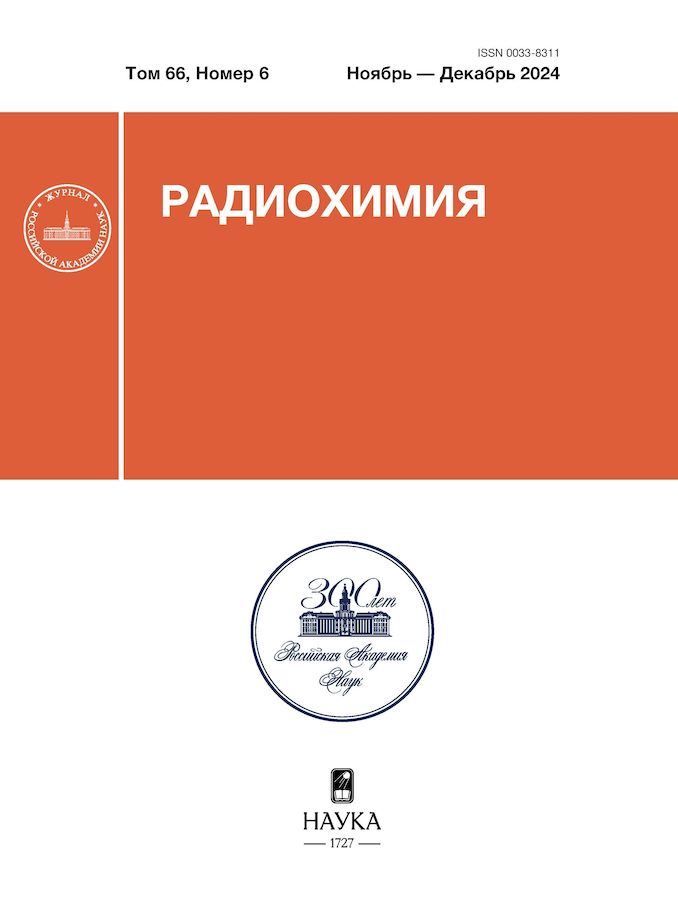Extraction of ytterbium from nitric acid with hexane solutions of 2-ethylhexylphosphonic acid mono-2-ethylhexyl ester
- Autores: Bobrovskaya K.S.1, Kuznetsov R.A.1
-
Afiliações:
- Kapitsa Research Institute of Technology, Ulyanovsk State University
- Edição: Volume 66, Nº 6 (2024)
- Páginas: 566-576
- Seção: Articles
- URL: https://ruspoj.com/0033-8311/article/view/681270
- DOI: https://doi.org/10.31857/S0033831124060078
- ID: 681270
Citar
Texto integral
Resumo
The extraction of ytterbium with solutions of mono(2-ethylhexyl) ether of 2-ethylhexylphosphonic acid (HEH[EHP]) in hexane from nitric acid solutions at an HEH[EHP] concentration of 0.5–2.0 mol/L, acidity of 0.1–2.0 mol/L, and lanthanide concentration from 0.1 to 5 g/L was studied. It is shown that the dependences of the ytterbium distribution coefficients on the acidity of the solution are described by expressions such as logD = alog[H+] + b, with the value of the coefficient a depending on the extractant and lanthanide concentrations and varying in the range from –1.26 to –3.0. The probable cause is extraction by both cation-exchange and solvation mechanisms. A model describing the dependence of the ytterbium distribution coefficient on its concentration in the aqueous phase at various extractant concentrations and acidities is proposed. The model reasonably agrees with the experimental data.
Texto integral
Sobre autores
K. Bobrovskaya
Kapitsa Research Institute of Technology, Ulyanovsk State University
Autor responsável pela correspondência
Email: rostislavkuznetsov@yandex.ru
Rússia, Ulyanovsk
R. Kuznetsov
Kapitsa Research Institute of Technology, Ulyanovsk State University
Email: rostislavkuznetsov@yandex.ru
Rússia, Ulyanovsk
Bibliografia
- Dash A., Chakravarty R., Knapp Furn F., Pillai A.M.R. // Curr. Radiopharm. 2015. Vol. 8. N. 2. P. 107. https://doi.org/10.2174/1874471008666150312161942
- Tarasov V., Andreev O., Romanov E., Kuznetsov R., Kupriyanov V., Tselishchev I. // Curr. Radiopharm. 2015. Vol. 8. N 2. P. 95. https://doi.org/10.2174/1874471008666150312160855
- Qi D. Hydrometallurgy of Rare Earths: Extraction and Separation. Elsevier Science, 2018. 804 p. https://doi.org/10.1016/b978-0-12-813920-2.00002-7
- Dash A., Pillai M.R.A., Knapp F.F. // Nucl. Med. Mol. Imaging. 2015. Vol. 49. N 2. P. 85. https://doi.org/10.1007/s13139-014-0315-z
- Kuznetsov R.A., Bobrovskaya K.S., Svetukhin V.V., Fomin A.N., Zhukov A.V. // Radiochemistry. 2019. Vol. 61. N 4. P. 381–395. https://doi.org/10.1134/S1066362219040015
- Horwitz E.P., McAlister D.R., Bond A.H., Barrans R.E., Williamson J.M. // Appl. Radiat. Isot. 2005. Vol. 63. P. 23. https://doi.org/10.1016/j.apradiso.2005.02.005
- Амбул Е.В., Голецкий Н.Д., Медведева А.И., Наумов А.А., Пузиков Е.А., Афонин М.А., Шишкин Д.Н. // Радиохимия. 2022. Т. 64. № 3. С. 233. https://doi.org/10.31857/S0033831122030054
- Амбул Е.В., Голецкий Н.Д., Наумов А.А., Пузиков Е.А., Мамчич М.В., Бизин А.В., Медведева А.И. // Радиохимия. 2023. T. 65. № 3. С. 226. doi: 10.31857/S0033831123030036
- Zhengshui Hu, Ying Pan, Xun Fu, Ying Pan // Solvent Extr. Ion Exch. 1995. Vol. 13. N 5. P. 965. https://doi.org/10.1080/07366299508918312
- Zhu Z., Bian Z., Long Z. // Anal. Meth. 2010. Vol. 2. P. 82. https://doi.org/10.1039/b9ay00187e
- Quinn J.E., Soldenhoff K.H., Stevens G.W., Lengkeek N.A. // Hydrometallurgy. 2015. Vol. 157. P. 298. http://doi.org/10.1016/j.hydromet.2015.09.005
- Lumetta G.J., Sinkov S.I., Krause J.A., Sweet L.E. // Inorg. Chem. 2016. Vol. 55. N 4. P. 1633. https://doi.org/10.1021/acs.inorgchem.5b02524
- Grimes T.S., Tian G., Rao L., Nash K.L. // Inorg. Chem. 2012. Vol. 51. P. 6299. https://doi.org/10.1021/Ic300503P
- Shu Q., Khayambashi A., Wang X., Wei Y. // Adsorp. Sci. Technol. 2018. Vol. 36. P. 1049. https://doi.org/10.1177/0263617417748112
- Su W., Chen Ji, Jing Yu, Liu Ch., Deng Yu, Yang M. // J. Rare Earths. 2018. Vol. 36. N 5. P. 505. https://doi.org/10.1016/j.jre.2017.10.008
- Lécrivain T., Kimberlin A., Dodd D.E., Miller S., Hobbs I., Campbell E., et al. // Solvent Extr. Ion Exch. 2019. Vol. 37. N 3. P. 284–296. https://doi.org/10.1080/07366299.2019.1639371
- Kolarik Z. // Solvent Extr. Ion Exch. 2010. Vol. 28. N 6. P. 707. https://doi.org/10.1080/07366299.2010.515172
- Tasaki Y., Abe Y., Ooi K., Narita H., Tanaka M., Wakisaka A. // Sep. Purif. Technol. 2016. Vol. 157. P. 162. https://doi.org/10.1016/j.seppur.2015.11.038
- Ooi K., Tasaki-Handa Y., Abe Y., Wakisaka A. // Dalton Trans. 2014. Vol. 43. P. 4807. https://doi.org/10.1039/c3dt53407c
Arquivos suplementares
















